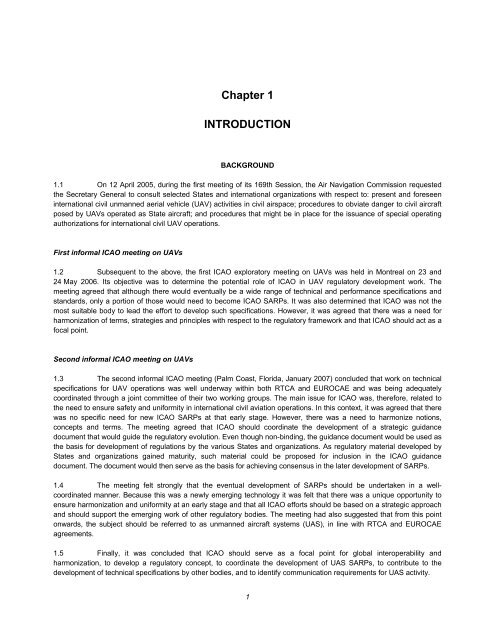1AswVkP
1AswVkP
1AswVkP
You also want an ePaper? Increase the reach of your titles
YUMPU automatically turns print PDFs into web optimized ePapers that Google loves.
Chapter 1<br />
INTRODUCTION<br />
BACKGROUND<br />
1.1 On 12 April 2005, during the first meeting of its 169th Session, the Air Navigation Commission requested<br />
the Secretary General to consult selected States and international organizations with respect to: present and foreseen<br />
international civil unmanned aerial vehicle (UAV) activities in civil airspace; procedures to obviate danger to civil aircraft<br />
posed by UAVs operated as State aircraft; and procedures that might be in place for the issuance of special operating<br />
authorizations for international civil UAV operations.<br />
First informal ICAO meeting on UAVs<br />
1.2 Subsequent to the above, the first ICAO exploratory meeting on UAVs was held in Montreal on 23 and<br />
24 May 2006. Its objective was to determine the potential role of ICAO in UAV regulatory development work. The<br />
meeting agreed that although there would eventually be a wide range of technical and performance specifications and<br />
standards, only a portion of those would need to become ICAO SARPs. It was also determined that ICAO was not the<br />
most suitable body to lead the effort to develop such specifications. However, it was agreed that there was a need for<br />
harmonization of terms, strategies and principles with respect to the regulatory framework and that ICAO should act as a<br />
focal point.<br />
Second informal ICAO meeting on UAVs<br />
1.3 The second informal ICAO meeting (Palm Coast, Florida, January 2007) concluded that work on technical<br />
specifications for UAV operations was well underway within both RTCA and EUROCAE and was being adequately<br />
coordinated through a joint committee of their two working groups. The main issue for ICAO was, therefore, related to<br />
the need to ensure safety and uniformity in international civil aviation operations. In this context, it was agreed that there<br />
was no specific need for new ICAO SARPs at that early stage. However, there was a need to harmonize notions,<br />
concepts and terms. The meeting agreed that ICAO should coordinate the development of a strategic guidance<br />
document that would guide the regulatory evolution. Even though non-binding, the guidance document would be used as<br />
the basis for development of regulations by the various States and organizations. As regulatory material developed by<br />
States and organizations gained maturity, such material could be proposed for inclusion in the ICAO guidance<br />
document. The document would then serve as the basis for achieving consensus in the later development of SARPs.<br />
1.4 The meeting felt strongly that the eventual development of SARPs should be undertaken in a wellcoordinated<br />
manner. Because this was a newly emerging technology it was felt that there was a unique opportunity to<br />
ensure harmonization and uniformity at an early stage and that all ICAO efforts should be based on a strategic approach<br />
and should support the emerging work of other regulatory bodies. The meeting had also suggested that from this point<br />
onwards, the subject should be referred to as unmanned aircraft systems (UAS), in line with RTCA and EUROCAE<br />
agreements.<br />
1.5 Finally, it was concluded that ICAO should serve as a focal point for global interoperability and<br />
harmonization, to develop a regulatory concept, to coordinate the development of UAS SARPs, to contribute to the<br />
development of technical specifications by other bodies, and to identify communication requirements for UAS activity.<br />
1


